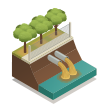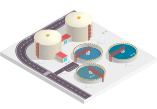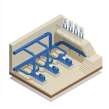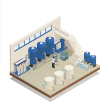TECHNOLOGY
Certificates, Verification, and Designation
Environmental New
Technology Certification
Certification No. 547
Environmental New
Technology Verification
Verification No. 226
Water Treatment Process

Novelty of new environmental technology
| Technology to improve maintenance and management efficiency of separation membranes | Technology to effectively control membrane contamination | Technology to reduce power costs | Technology to maximize phosphorus emission |
|---|---|---|---|
| Using an external flat-membrane separation tank (MBR housing) separated from the aerobic tank | Using the physical cleaning technology (backwashing and cleaning ball) in the external circulating membrane separation tank | Applying gravitational filtration , microbubbles, and low load aeration in operation of membrane separation tank | Anaerobic tank and JBB, and split source water inflow |
Excellence of new environmental technology
| Treatment Efficiency |

|
- More than 95.4% total phosphorus processing (T-P < 0.025 ppm) without the input of coagulant - More than 78.8% total nitrogen treatment without input of organic carbon sources ⇨ More than 95% nitrification during water temperature drop in winter (6.5℃) |
|---|---|---|
| Construction |

|
- Capacity expansion and improvement of existing facilities without changing civil structures (continuous construction is possible) ⇨ Minimized discharge of untreated sewage during capacity expansion and improvement work |
| Operation |

|
- The external flat membrane separation tank acts as a cleaning tank, allowing it to clean without moving the separation membrane (no hoist required.) - Application of IcT & IoT function enables the self-diagnosis of the separation membrane and automated cleaning. - Automated cleaning of the separation membrane Notify the manager of when to clean ⇨ Preparation of the cleaning chemicals (Manager) ⇨ Automated cleaning ⇨ Send TMP text before and after cleaning to manager ⇨ Normal operation |
| Maintenance |

|
Reduction of the cost of chemicals through chemical-free treatment process - Minimized the amount of sludge generated by not using coagulant - Reduction of power consumption through low load aeration and gravity filtration |